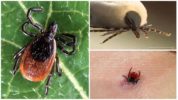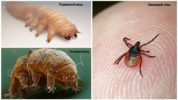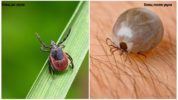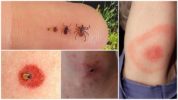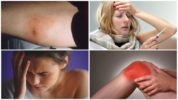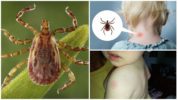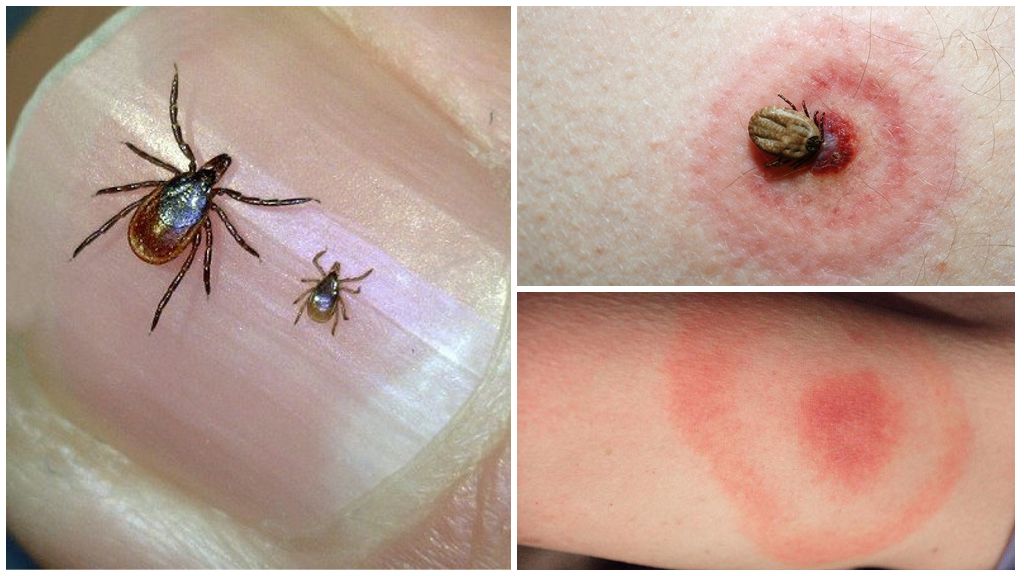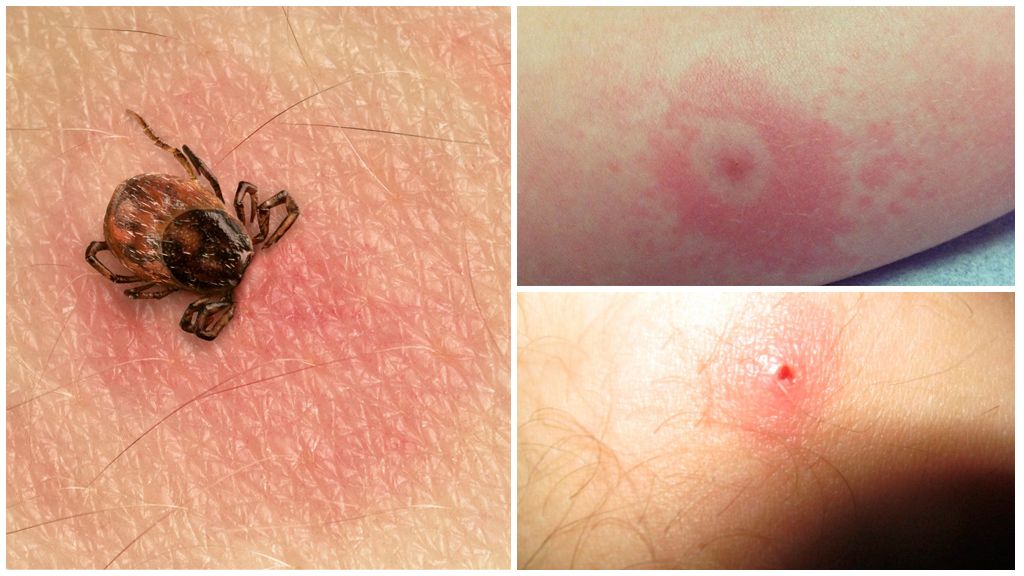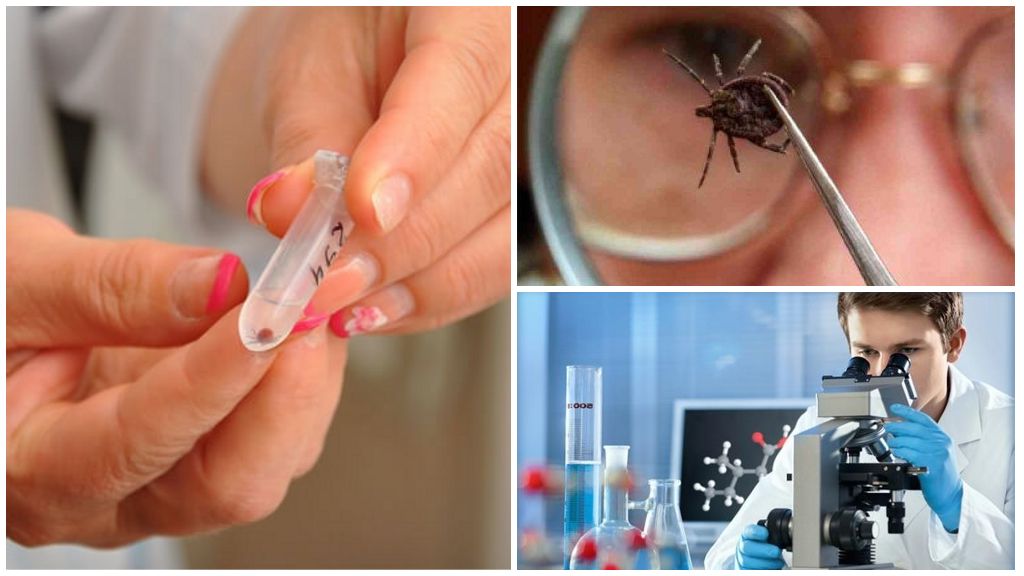- Description and lifestyle
- Types of "bloodsuckers"
- How to bite a tick
- What does a tick bite look like?
- How to identify a tick bite
- What can be infected from a tick bite
- Tick-borne encephalitis
- Lyme Disease or Borreliosis
- Hemorrhagic fever
- Symptoms of other infectious diseases
- What to do if a tick has bitten - instructions
- First aid for a tick bite
- Tick bites in children
- What can not be done with tick bites
- Bite Prevention
- Mite
- Types of Ticks
- Tick before and after bite
- Tick bite
- Negative symptoms after a tick bite
- Symptoms of disease after being bitten by an infected tick
- First aid for a tick bite
- Tick bite in children
Summer brings not only sunny weather and the possibility of outdoor recreation, but also a high probability of getting a tick bite. Such a nuisance is associated not only with the problems of removing the parasite from the body and subsequent treatment, but also with the ability to tolerate some infectious diseases that are dangerous to human health, the symptoms of which must be known in order to avoid further complications or infectious diseases.
Description and lifestyle
Ticksthat are common in central Russia, inhabit in the forest among foliage and in garden plots, that is, wherever there are any plantings. They belong to the order of small arachnids (lat. Acarina), a subclass of arthropods. Tick size before a bite it is usually 0.4-0.5 mm, occasionally it can reach 3 mm.
The body of the parasite consists of 2 parts and 6 pairs of appendages: 4 of them are legs, a pair of pedipalps, and the front ones, chelicera, similar to claws, form a cutting-piercing mouth, which is clearly visible in an enlarged photo of a common tick.
On a note!
The active period in ticks It begins in May-June and lasts the entire warm season, the maximum risk of bites is in dry and warm weather. The basis of their nutrition is human blood and mammals, which they drink with the help of a special organ, as can be seen in the photo of the proboscis of the tick. They determine the proximity of the victim by smell at a distance of 10-15 m.
The danger of tick bites is that they instantly pierce the skin along with the proboscis and head, then they begin to suck out blood, that a person can not always understand that a tick has bitten because of its small size. And only when the parasite inflates from the drunk blood, it increases and becomes noticeable on the body. Then the victim, having discovered a tick, can begin measures to remove it and treat a bitten place.
Therefore, it is better to know in advance how long the symptoms of a tick bite appear in a person in order to take measures and clarify the possibility of infection from him by any infections.
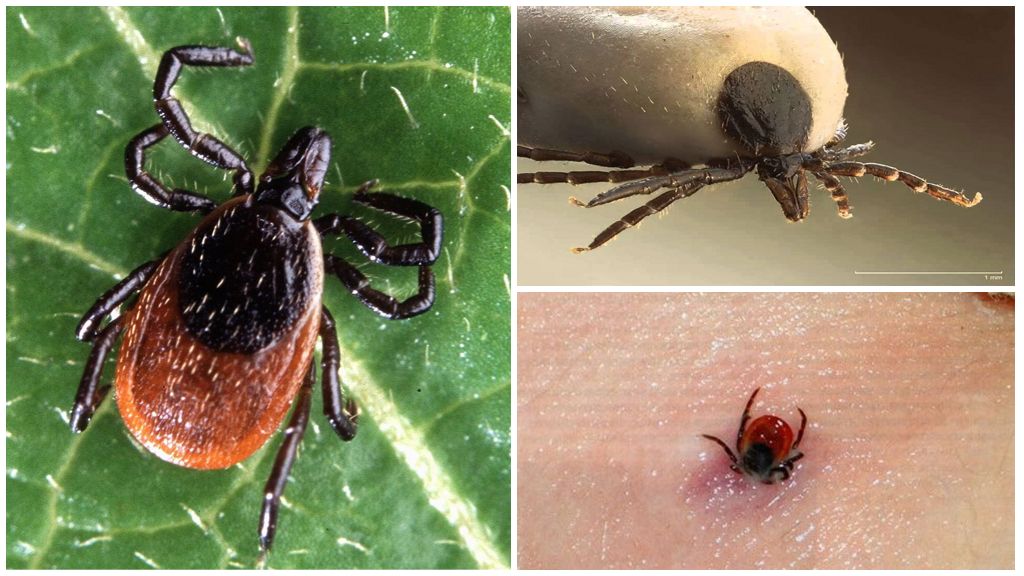
Types of "bloodsuckers"
The most common tick species found in Russia:
- Ixodic(lat. Ixodidae) - the most dangerous for humans, belong to the family of bloodsucking, parasitic on animals. Its largest representatives in the normal state have a length of 1.3 cm, and after consuming a portion of blood - up to 2.5 cm, as can be seen in the photo of the pumped tick. After penetration under the skin, the tick is fixed there with a special outgrowth in the mouth, so when pulling the parasite head remains in the host body.
- Demodex or subcutaneous - refers to conditionally pathogenic, constantly living on the skin of a person on the face and other areas.It lives at the base of the hair follicles and feeds on skin particles and secreted fat from the glands. Activation subcutaneous ticks occurs with a decrease in immunity or a violation of the hormonal background and is expressed in the inflammatory process and the appearance of acne and ulcers. The smallest sizes of demodex (0.3 mm) allow you to see on the photo of a sucking tick under the skin only with a large magnification under the microscope.
- Bed parasites or dust (size 0.1-0.2 mm) - live only in bedding. Their diet is not blood, but dead skin particles. Leaving the results of their vital activity on the human body, such small ticks can cause strong allergic reaction on the body of his victim. Photos of ticks are presented below.
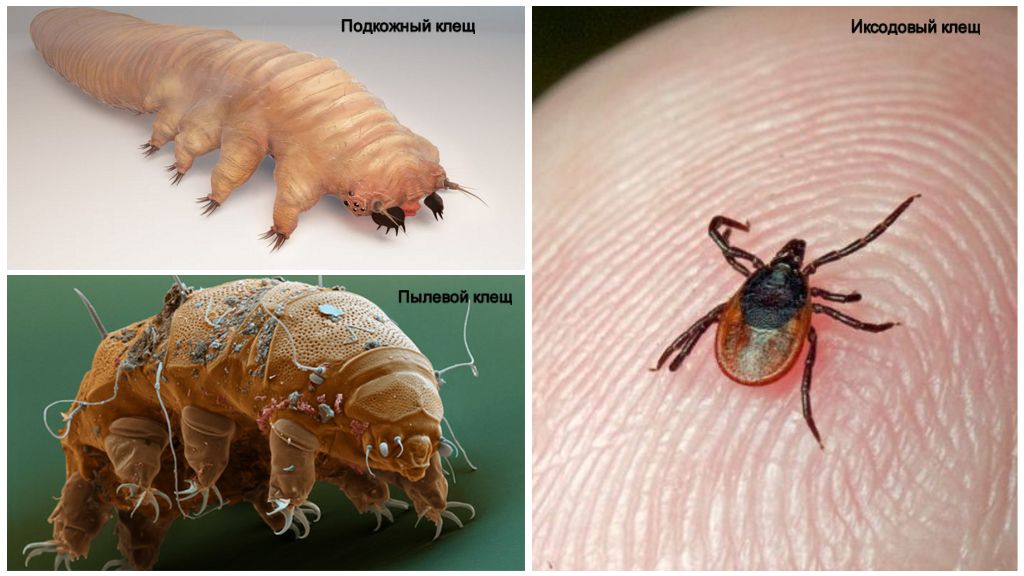
How to bite a tick
Immediately during the bite, the parasite injects an anesthetic, so the victim does not feel the process of being bitten by a tick, and during this time the parasite has time to start drinking blood. And only after 15-20 minutes, when a red spot appears and itches, their reason becomes clear.
Moreover, the male tick after the bite, after drinking, immediately disappears, but the female, as can be seen in the photo of the tick before and after the bite, greatly increases in size when the blood is absorbed. She can cling to the skin so tightly, crawling there with her head and proboscis, that it will be very difficult to get it.
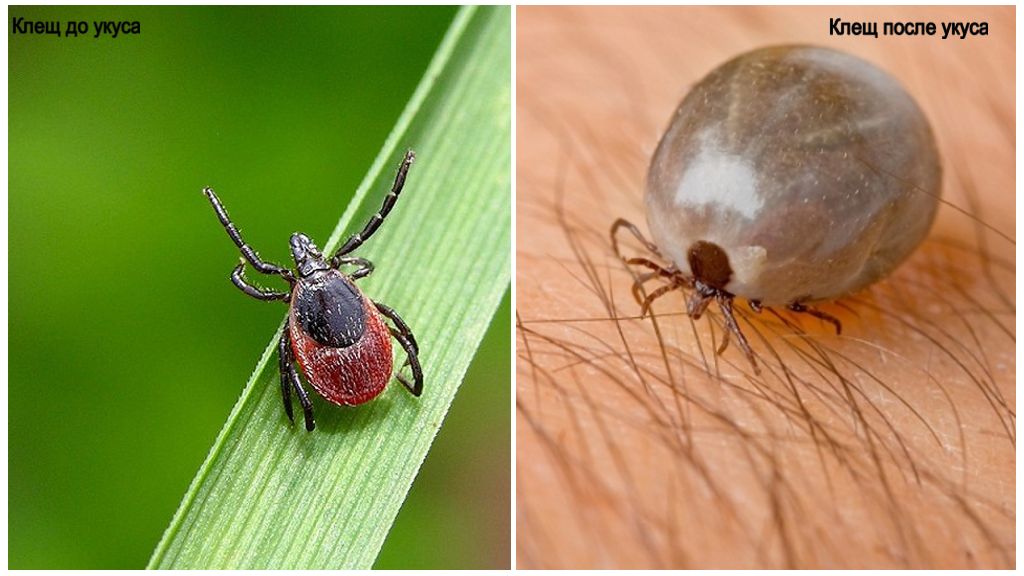
On a note!
After suction, the tick can stay on the body for several days until a person notices it or will fall off on my own.
Ticks are carriers of diseases dangerous to humans: infectious encephalitis, borreliosis, ehrlichiosis, tularemia and others. If the parasite was infected with a virus, it can infect its victim by injecting saliva. However, the first symptoms do not appear immediately, but only 7-24 days after the bite, occasionally - after 1-2 months.
On a note!
The duration of the incubation period after a tick bite depends on the state of health of the victim and its blood-brain barrier.
He selects the area on the victim’s body based on the softness of the skin tissue. The most common places for tick bites on the human body:
- chest, axillary area, neck;
- place behind the ears;
- stomach and inguinal zone;
- lower back;
- the inner sides of the elbows on the hands and lower legs on the legs, under the knees;
- in the middle of the hair in the head;
- limbs and exposed skin.
It is these zones that are recommended to be inspected in order to find a tick after each walk in nature and a trip to a picnic.
What does a tick bite look like?
Most often, a person at first does not notice a parasite on the skin, because outwardly you can confuse a tick with a small mole. It becomes noticeable when it swells from the drunk blood, but has not yet had time to fall off on its own. Redness, slight swelling or coneas seen in the photo of a tick bite, and are also present burning or itching sensations. Some people with hypersensitivity may experience allergic reactions.

In rare cases, negative symptoms appear after a tick bite, especially when infected with any disease:
- the bite site hurts, swelling of the surrounding tissues, shortness of breath;
- a rash that spreads throughout the body;
- headache, chills, fever;
- photophobia;
- joint pain, numbness in some areas or limbs;
- difficulty walking due to leg paralysis;
- sleep disturbance, loss of appetite.
Important!
With an acute reaction to a tick bite, sharp bouts of nausea and vomiting, temperature jump, extensive swelling, tachycardia, or even fainting, you must urgently call an ambulance.
How to identify a tick bite
Determine the appearance of the affected area, which insect has bitten a person, is possible only by some signs.This is especially difficult to do if there is a tick bite without a tick that has already fallen on its own.
Important!
A characteristic feature that distinguishes a tick bite is the ring shape of the affected area: in its middle is the center of red, surrounded by rims, initially pale, then bright. Such rings are clearly visible in the photograph of a tick bite mark in a person, regardless of whether there is a sucking parasite on it.
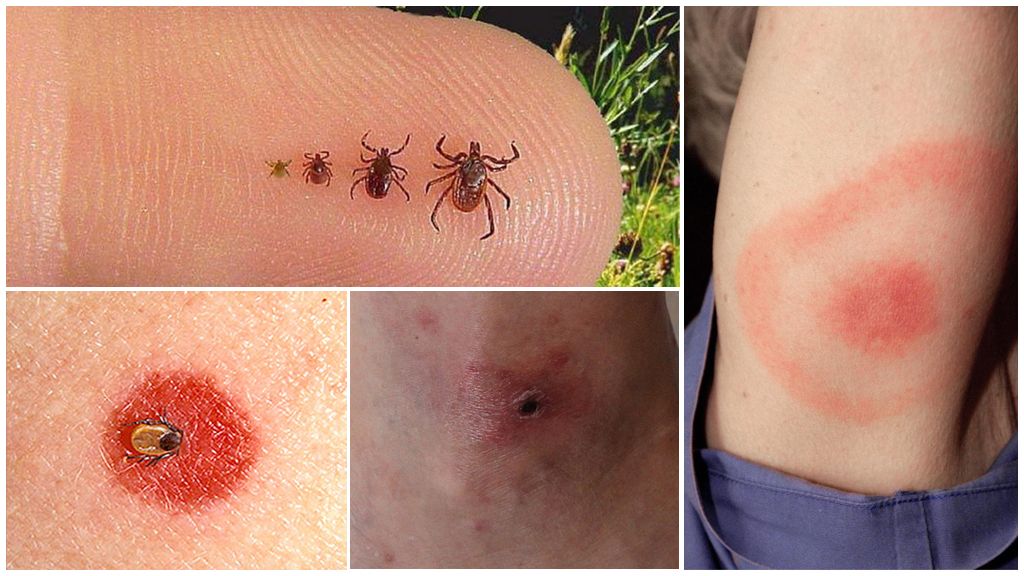
After the “bloodsucker” disappears itself, or it was removed, the victim remains a dense, but not very painful blister with a hole from the proboscis.
What can be infected from a tick bite
The list of diseases that "bloodsuckers" can carry reaches 60 pcs. However, we will consider the most common diseases in more detail. The above symptoms will help a person who has been bitten by a tick in his head, leg, or other parts of his body to monitor his health condition in time to notice its deterioration and consult a doctor for treatment.
Tick-borne encephalitis
This is a viral disease that affects the human nervous system. Incubation period is 4-14 days. Then the infection causes the following unpleasant symptoms:
- a sharp increase in body temperature;
- muscle weakness, numbness of the limbs and neck;
- redness of the face, eyes and oral mucosa;
- severe headaches;
- loss of appetite, nausea and vomiting.
Important!
The negative consequences of a tick bite with this disease are quite severe: neurological pathologies, personality changes, disability and even death are possible. The first symptoms of the disease may appear within a week after infection, possibly prophylaxis.
Lyme Disease or Borreliosis
The disease is transmitted by bacteria that cause intoxication of the body. The incubation period: 5-14 days, the disease goes through several stages, the primary symptoms are like a cold, and then comes the latent form, which takes several months, during which the joints and important organs of the person are affected.
Signs of infection are expressed in the following:
- a sharp increase in temperature;
- headaches, constant tiredness;
- the site of the tick bite is swollen and reddened, then a specific erythema 10-20 cm in size appears, which gradually swells and transforms from a red spot into a ring up to 60 cm in diameter, in the center its color changes to light bluish;
- a few days later, a crust or scar forms, which disappear after 12-14 days.
Such a disease after a tick bite causes damage to the nervous, cardiovascular and motor systems, which can lead to disability.
Hemorrhagic fever
The disease is transmitted by a virus, the main symptoms of which are: a sharp increase in temperature and the onset of fever, hemorrhages in the upper layers of the skin, a change in the blood composition of the victim. Specialists divide the disease into 2 types: Omsk and Crimean fever. Timely diagnosis and treatment of a tick bite (antiviral drugs, vitamins for blood vessels) help to successfully cope with such an ailment.
On a note!
The carriers of these diseases are not all "bloodsuckers" who attempt to inflict human blood, but only 10-20% of them. But some specimens can become carriers of several infections at once, the most common of which is tick-borne encephalitis.
Symptoms of other infectious diseases

Any bite of an infected tick can result in a serious human disease. The situation is complicated by the fact that many diseases begin to manifest only a few days after the attack of the parasite. In addition to an increase in temperature, easily mistaken for signs of a starting cold, there are other possible consequences that will help determine that a person has been infected by a tick bite:
- jumps in blood pressure, tachycardia (heart palpitations);
- plaque on the tongue, runny nose, sore throat;
- nausea and vomiting;
- enlarged lymph nodes and the appearance of rashes on the face are signs of typhus;
- bleeding from the nose, diarrhea and abdominal pain - indicate infection with tularemia;
- excessive sweating, chills, pain in the lumbar region, loss of consciousness - signs of hemorrhagic fever.
Important!
It is impossible to recognize a tick and determine by eye whether it is contagious or not. To clarify the diagnosis it is necessary take to the nearest laboratory or a sanitary epidemiological station to determine the presence of pathogenic pathogens. If the test is positive, then you must urgently consult a doctor about treatment.
If any unpleasant symptoms occur and your health worsens when you bite a tick or after it, you need to contact a general practitioner or infectious disease doctor at the clinic, and if you are in serious condition, call an ambulance.
What to do if a tick has bitten - instructions
Returning from a walk through the woods or cottages, it is imperative to examine yourself, family and friends so as not to miss the settled tick on the leg or other parts of the body. When detected, it is necessary to quickly pull out the tick.
The site of the tick bite is usually painted in pink-red shades, which depends on the individual reaction of the victim's body. In the center there is a small depression in which you can find a digging tick on the human body. It holds very tight, so it is impossible to remove it in the usual way without tearing off your head or proboscis. If any of its parts remain under the skin, then the inflammatory process may begin in the damaged area and the bite heals for a long time.
To avoid complications, the parasite should be twisted out of the skin with the help of improvised tools:
- The easiest method is to remove the tick with tweezers: grabbing the upper body closer to the skin, it should be removed in a circular motion counterclockwise. After such manipulations, the body of the parasite gradually comes out. If you pull sharply, then in the hands there will be a tick without a head.
- Another effective remedy is a small segment of an ordinary sewing thread, from which a loop is made, they are thrown onto the "bloodsucker" and begin to turn in any direction, gradually removing it outward.
Also use syringe, special fixture. After the removal procedure, you need to look at the condition of the tick: if it is alive, then it is better to place it in a jar for transmission for examination. If there is no such need, then it can be burned and lowered into the sewer. Then, be sure to thoroughly wash your hands and tools.
First aid for a tick bite
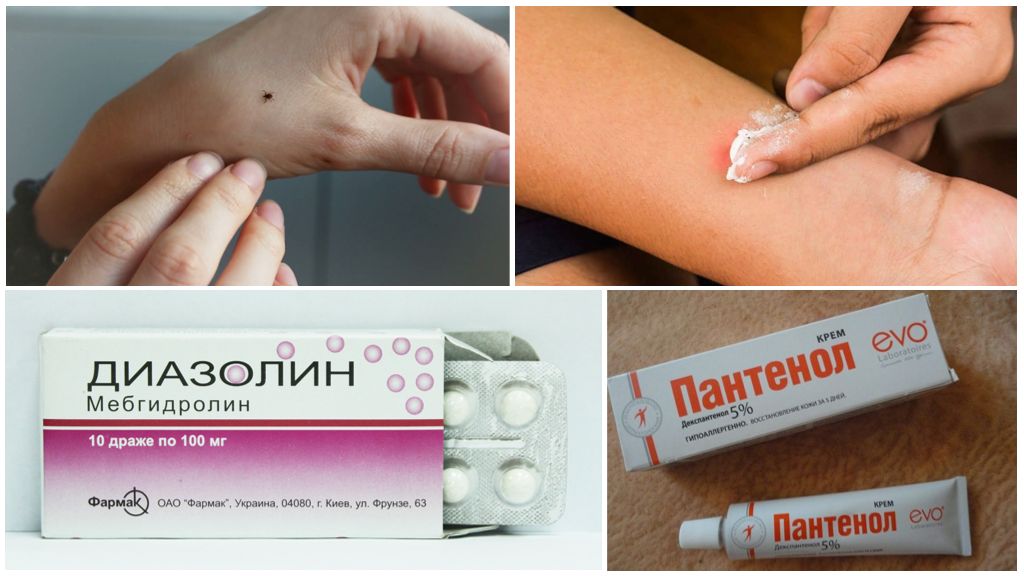
To avoid infection of a wound from a tick bite, you should correctly handle the bite site.
The following actions will be useful for this:
- Wash hands with soap.
- Treat the wound with a disinfectant: alcohol, hydrogen peroxide.
- It is not recommended to apply coloring agents (brilliant green or iodine), so as not to change the picture of the affected area.
- If an allergic reaction is likely to occur, apply any soothing ointment: Fenistil-gel, Panthenol, Rescue cream, etc.
- If a rash after a tick bite or other individual reaction is present, then an antihistamine should be taken: Diazolin, Tavegil, Loratadin, Erius, Tsetrin, etc.
- Drink plenty of fluids; bed rest is recommended in the early days.
Tick bites in children
If a child is bitten by a tick, it is advisable to contact the emergency room to remove the pest. In babies, the reaction to a tick bite in the arm or other part of the body is manifested by rounded redness or swelling. If the parasite is removed promptly and accurately, then after a few hours a small bump with a red rim swells on the skin, which gradually begins to heal, as can be seen in the photo of a tick bite in children. Healing and swelling reduction occur within 2 weeks.
Important!
The child’s body usually reacts more sharply to parasite saliva, so if the child experiences the first negative symptoms within 3 hours after the bite of the child in the form of dizziness, weakness, fever, photophobia, we can conclude that infection is likely. Parents should consult a doctor who can recommend immunoglobulinAnaferon or antibiotic iodantiprine.
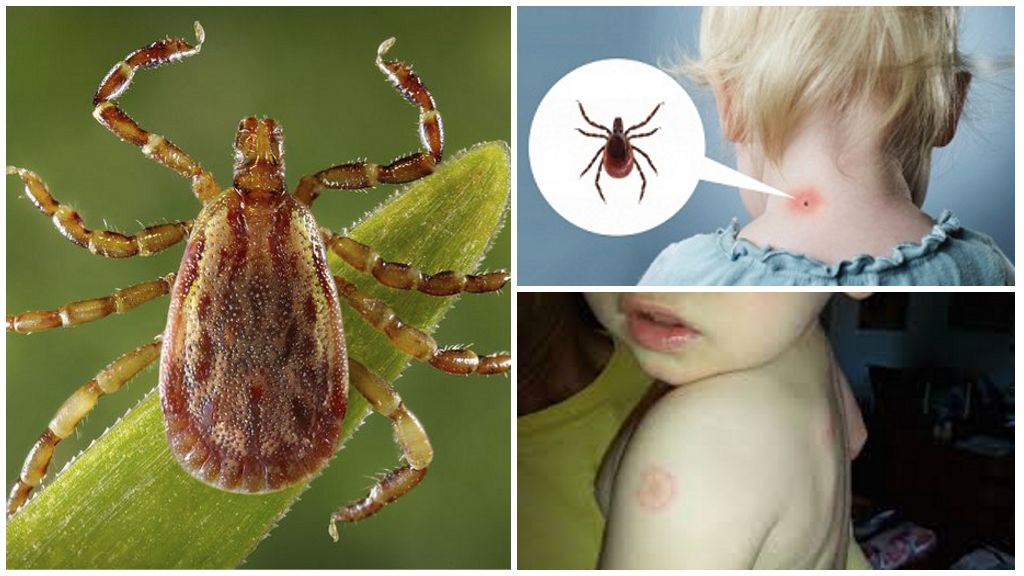
What can not be done with tick bites
If there are signs of a tick bite on your body or the parasite itself, it is strictly forbidden to apply the following actions:
- lubricate the "bloodsucker" with vegetable oil, which, contrary to the prevailing erroneous opinion, not only does not make it crawl out, but also stimulates it after suction to regurgitate the blood, which increases the risk of infection and inflammation;
- cauterize the tick with caustic liquids (gasoline, kerosene) or a burning cigarette;
- pull it sharply, which always leads to rupture of the body, and the head remains under the skin, which, according to reviews of a tick bite, often leads to suppuration of the wound;
- try to crush the parasite;
- pick it with a disinfected needle or other dirty objects.
All the above actions increase the risk of human infection with bacteria and infectious diseases, lead to purulent processes in the epidermis.
Bite Prevention
In order not to think about whether a tick was bitten or not during a visit to a forest, park or summer cottage, and what consequences this may lead to, preventive measures should be taken that will protect children and adults from such a problem:
- put on light clothing, on which crawling insects are clearly visible, with long sleeves and adjacent cuffs;
- handle clothes repellents or daunting acaricidal sprayswhose smells do not tolerate ticks;
- beware of walking or sitting in tall grass, where parasites lie in wait for their victim to climb on it;
- before visiting the area, where tick-borne encephalitis is commonrecommended to do vaccination to develop immunity;
- After a walk, carefully inspect clothing and skin for sucking parasites.
The given recommendations will allow to avoid the attack of “bloodsuckers” and the possible negative consequences.
